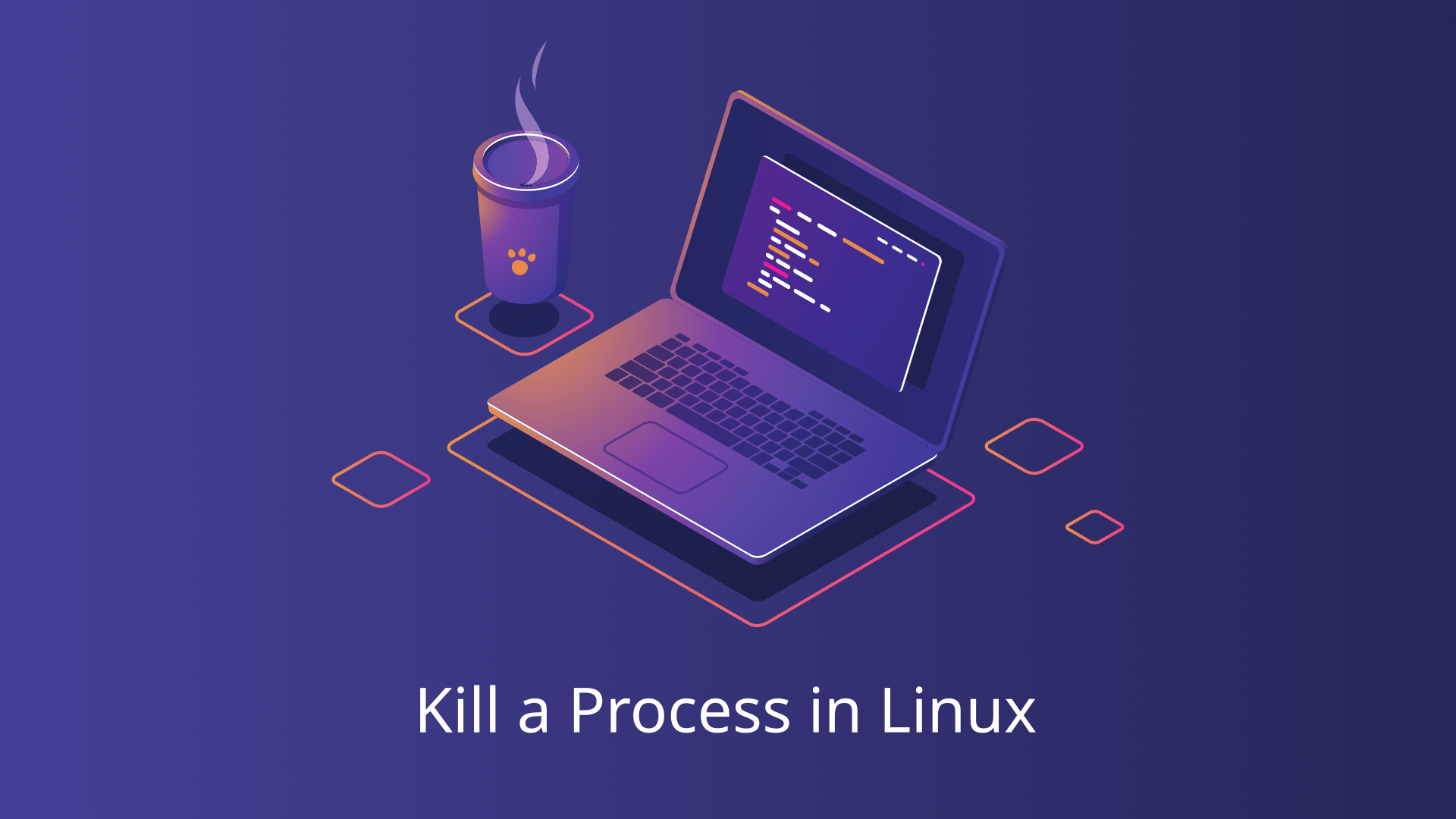In Linux, a process is an instance of a running program. Processes can be system processes, user processes, or services running in the background. Each process is assigned a unique identifier known as the Process ID (PID), which allows the system and users to track and manage it. Whether it’s dealing with unresponsive applications or terminating unnecessary processes, knowing how to kill processes in Linux is an essential skill for system administrators and power users alike.
This comprehensive guide will cover various methods to kill processes, including using the process ID (PID) and terminating all processes by a specific user. We’ll also explore some common commands and scenarios.
Process States
Processes in Linux can be in various states during their lifecycle. Understanding these states is crucial for effective process management.
- Running (R): The process is either executing on the CPU or waiting to be executed.
- Sleeping (S): The process is waiting for an event to occur (e.g., I/O operation). There are two types of sleeping states:
- Interruptible Sleep (S): The process can be awakened by signals.
- Uninterruptible Sleep (D): The process is waiting for a hardware condition and cannot be interrupted.
- Stopped (T): The process has been stopped, usually by receiving a signal.
- Zombie (Z): The process has completed execution, but its exit status is not yet read by its parent process.
Listing Running Processes
Before killing a process, it’s often necessary to list the running processes to identify the target process. Here are some commonly used commands to list processes:
The ps Command
The ps command provides a snapshot of the current processes. It has various options to display different levels of detail.
ps auxThis command lists all processes with detailed information, including the user, PID, CPU usage, memory usage, and command.
The top Command
The top command displays real-time information about running processes, including their resource usage.
topThis command provides a dynamic view of the system’s processes, updating the information periodically.
The htop Command
htop is an enhanced version of top with a more user-friendly interface and additional features.
htopThis command provides an interactive view of the system’s processes, allowing for easier navigation and management.
The pgrep Command
pgrep allows users to search for processes by name and other attributes, returning their PIDs.
pgrep [process_name]Basic Commands to Kill a Process
Managing processes is an essential part of maintaining a stable and efficient Linux system. Among the various tasks, knowing how to kill a process is crucial.
The kill Command
The kill command is the most straightforward method for terminating a process. It sends a signal to the process specified by its Process ID (PID). The most commonly used signal is SIGTERM (signal number 15), which politely requests the process to terminate. If the process does not respond, the SIGKILL (signal number 9) can be used to forcefully terminate it.
Syntax
kill [signal] PIDTo terminate a process with PID 1234:
kill 1234Using kill with Different Signals
Linux supports a variety of signals that can be sent to processes. Some of the most commonly used signals include:
SIGTERM (15): Requests the process to terminate. This is the default signal if no signal is specified.
SIGKILL (9): Forces the process to terminate immediately. The process cannot ignore this signal.
SIGINT (2): Interrupts the process, similar to pressing Ctrl+C in the terminal.
Examples
Terminating a Process
kill 5678This command sends the SIGTERM signal to the process with PID 5678, allowing it to terminate gracefully.
Forcing a Process to Terminate
kill -9 5678This command sends the SIGKILL signal to the process with PID 5678, forcing it to stop immediately.
Interrupting a Process
kill -2 5678This command sends the SIGINT signal to the process with PID 5678, interrupting its execution.
Verifying Process Termination
After issuing a kill command, it’s prudent to verify that the process has indeed terminated. This can be done using the ps command to check for the presence of the process.
ps -p 5678If the process has been terminated, this command will not return any output. If the process is still running, it will display the process details.
Killing Multiple Processes
To kill multiple processes simultaneously, you can use a loop or combine kill with other commands like pgrep or ps.
Example using pgrep:
kill $(pgrep [process_name])This command finds all PIDs of processes with the specified name and sends the SIGTERM signal to each.
The killall Command
The killall command terminates all instances of a specified process by name. This is useful when you need to stop multiple processes of the same program without finding their PIDs individually.
Syntax
killall [options] process_nameKilling a Process by Name
To terminate all instances of a process named firefox:
killall firefoxIf the processes do not respond, you can forcefully terminate them:
killall -9 firefoxThe pkill Command
The pkill command is similar to killall but provides more flexibility. It allows you to kill processes based on various criteria such as process name, user, and other attributes. This command can be particularly powerful for managing processes owned by a specific user or matching a particular pattern.
Syntax
pkill [options] patternKilling All Processes by a User
To terminate all processes owned by the user john:
pkill -u johnKilling a Process by Name
To terminate all instances of a process named chrome:
pkill chromeKilling Zombie Processes
A zombie process, also known as a defunct process, is a process that has completed execution but still has an entry in the process table. While zombies do not consume system resources, they can accumulate and cause system clutter.
Identifying Zombie Processes
Use the ps command to list processes and look for processes marked with Z (zombie):
ps aux | grep 'Z'Eliminating Zombie Processes
Identify the parent process (PPID) of the zombie process. Terminate or restart the parent process to clean up the zombie:
kill -HUP PPIDIf necessary, forcefully terminate the parent process:
kill -9 PPIDKilling All Processes by a User
In some situations, you may need to terminate all processes initiated by a specific user. This can be particularly useful for managing multi-user systems, handling misbehaving applications, or performing maintenance tasks.
Identifying Processes Owned by a User
Before terminating processes, it is essential to identify all processes owned by the user in question. Several commands can help you list these processes:
Using the ps Command
The ps command, combined with the -u option, allows you to list all processes owned by a specific user. To list all processes owned by the user john:
ps -u johnThis command outputs a list of all processes owned by john, including their PIDs.
Using the pgrep Command
The pgrep command can also be used to list PIDs of processes owned by a specific user. To find the PIDs of all processes owned by john:
pgrep -u johnThis command outputs the PIDs of all processes owned by john.
Killing All Processes Owned by a User
Once you have identified the processes, you can use various commands to terminate them. The pkill and killall commands are particularly effective for this purpose.
Using the pkill Command
The pkill command is a powerful tool that can kill processes based on various criteria, including the user who owns them.
To kill all processes owned by the user john:
pkill -u johnThis command sends the default SIGTERM signal to all processes owned by john, requesting them to terminate gracefully.
If the processes do not respond to SIGTERM, you can use the -9 option to send the SIGKILL signal and forcefully terminate them:
pkill -9 -u johnThis command forcefully kills all processes owned by john.
Using the killall Command
The killall command can also be used to terminate all processes of a specific user by combining it with other commands.
First, list all processes owned by john and pass their PIDs to killall using xargs:
ps -u john -o pid= | xargs kill -9This command lists all PIDs of processes owned by john and then forcefully terminates them using kill -9.
Conclusion
Killing processes in Linux is a fundamental skill for system administration. By understanding the various commands and options available, you can effectively manage and terminate processes as needed. Whether you’re dealing with a single unresponsive process or need to kill all processes by a user, the commands covered in this guide provide a comprehensive toolkit for process management.




